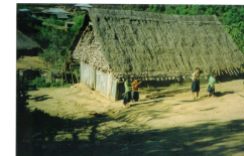The Akha are a relatively poor but a culturally unique people living in the high mountains of Northern Thailand, formerly involved solely in opium cultivation but now virtuous fruit farmers – or mostly so. Rumour has it that some still harvest the poppy but “for their own use” as it eases the back-breaking work of being a hill farmer. More than 55,000 of the Akha are now engaged in cultivating cash crops like maize, soya, coffee, tea and fruits.
Hailing originally from Tibet, migrating by way of Yunnan and Burma, the Akha arrived in Thailand in the late 19th century, speaking a form of Tibetan-Burmese which is still their main language.
Although the men dress quite simply in longhis and shirts, or shorts and shirts, the women’s costumes are exotic and the headgear astonishing. Of the many hill tribes, the Akha women’s dress is easily the most elaborate. On the head they wear a helmet-like piece made up of silver coins, beads and feathers the body covering being a long-sleeved jacket over a short cotton skirt decorated with embroidery and shells and ending just above the knees. Silver is the dominant metal for the Akha and they wear huge pendant earrings and broad, thick bands of silver around the neck.
Despite their shyness, they accept tourists in one of their villages, Huay Kee Lek, and visitors are welcome to spend a few days there learning about their culture and traditions. Huay Kee Lek is not new: it has been in existence for more than 50 years and includes what to the Akha is the most important feature of the compound, the ornately carved gate in which the guardian spirits of the village live. As Animists they believe in a world of spirits, both dangerous and benevolent, spirits who must be kept appeased lest they interfere with the life of the tribe and bring death, plagues and evil upon them.
Akha Children
There is a surprising number of Christian and Buddhist Akha, but even these give a nod in the direction of animism and involve themselves in protecting the sites set apart for the spirits, including the gate. This mirrors Thai society itself for although the population of the country is 95% Buddhist, the number of spirit houses on the forecourts of big business houses and residential properties, testify to a strong belief in animism in the country at large.
Tourists stay in a genuine stilt house with Akha families and can join the villagers as they journey to the fields after dawn, to observe how they work. Visitors will also be invited to explore the surrounding forests with one of the Akha guides on hand to explain the concept of sustainable forestry as it affects them. It took the government a long time to persuade the Akha from their traditional slash and burn system of farming (a system still in operation in some places) but population pressure and the loss of the forests seems to have convinced most of them to adopt sustainable farming in its place.

The “home-stays” money provided by tourists is used to help local conservation projects and to keep alive Akha culture, their traditional music and performance arts, all of which is an encouragement to the tribe to take pride in their traditions.
Huay Kee Lek is high up in the hills but it is relatively easy to reach on a good road from Mae Suai to the valley settlement and for anyone wishing to understand the life of the hill tribes, a few days spent in the village is all that is needed.








nice pics! 🙂
LikeLike
Thanks!
LikeLike
You are welcome 🙂
LikeLike